But before we return to India, we must return to sword swallowers. Yotam recovered a video of Johnny Fox doing his shtick on you tube, the very one I described in our last post. Further evidence that YouTube is one of mankind's greatest achievements. Along with Wikipedia. In case anyone missed Yotam's comment, below is the video:
Back to India. We take 2AC from Varanasi. Due to some scheduling conflicts not involving Outlook, we end up on a train, late, with no food. The train is hours late, and we get about 4 minutes notice to hustle onto the right platform, right train, and right car. All goes ok. A porter with an awesome turban directs us onto a car. But now we're starving, and we're told there's no food service, and all the wallahs with snacks have gone to bed. Regular Hungry Hungry Hippos, that's us. Magically, cold thalis arrive, filled mostly with liquid food, rice, and 2 roti (flat bread). Most food in India is structurally homogeneous, from curries and bread, to the spherical sweets. Some sweets have some structure. Food structuralism is one of my favorite topics, but it isn't a favored topic of this blog, at least not yet. Liquid food and rice is not an issue, generally, unless you don't get any silverware, because then, well, you have nothing to help convey the liquid food to your mouth.
Naturally, we don't get any silverware. Alex and I, however, having mastered the art of eating with our hands, dive into the thali, cleaning up every calorie on the silver platter. Our Japanese neighbor is not so prepared. He sadly, hungrily, and gingerly dips strips of roti into the food, and eats it, careful to get no daal or curry on his hands. Poor guy. It took a bit of reprogramming to get comfortable balling up rice and daal and eating with my own bare hands. But this poor guy? He's Japanese, very clean and polite, and would probably never dream of eating rice with his bare hands. Unless, maybe, it was some sort of nightmare dream. We remember how his female travel buddy at the station daintily cleaned some dust off her beautiful new Indian sandals. Sigh. Japan and India might be the two most different places on the planet, along many dimensions. Later, we make origami cranes together. All is good.
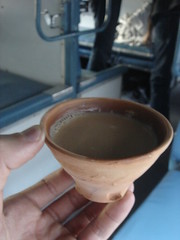
The Chai on trains is good. Sometimes we get things in earthen cups. Eco-friendly, and all! Not fully kiln fired. When finished, it turns back into earth. Cool, no?
The next day, we find ourselves in Agra, the number one tourist site of India, and begin the process of becoming Agrarians. Agra has the reputation as being the most oppressive tourist city in India. Of course, after Varanasi and Khajuraho, we're totally acclimated. I even finish bargaining with a rickshaw driver at one point, and do such a good job, he asks me if I'm Israeli. I am, I guess, but not how he means it -- as one of the hard bargaining Israeli travelers of legend. That's right, we're acquiring Skillz.
We stay in a slightly off the track guest house called the Tourist Rest House, off in nowhere Agra, near nothing in particular, which is fine by us, since we just want a day to relax. Our rickshaw driver is instructed to drop us off at a nearby location, and we don't divulge our final destination, since we've learned our lesson the hard way.
We decide to save Agra for last, doing nothing for first, and some other less famous, but almost as awesome Mughal architecture, for in between.
Nothing. Nothing. Nothing. Ok.

From the folks who brought you the Taj-Mahal, it should come as no surprise that an entire royal palace and city might be constructed outside of Agra city, some hour bus ride away, in what seems to be a desert. Above is the front door for the ruling compound. Fatehpur Sikri is the name of this city -- built, then later abandoned, due to water issues.
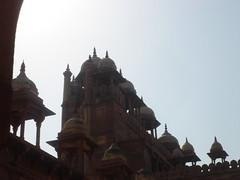
Above, a flock of towers.
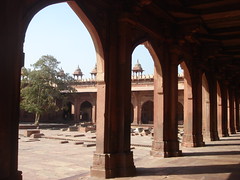
The big entryway opens onto a huge courtyard, too big to photograph. I took a few nibbles at it with my camera.
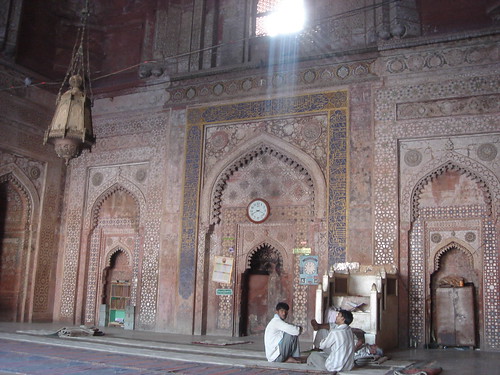
There's a lovely mosque off the side of the central courtyard.
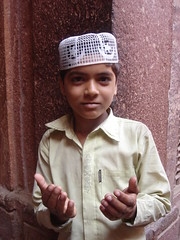
Kids are cute. We hire a guide, who makes up a bunch of stuff that may or may not be true. Alex and I realize we don't like having someone lead our attention around as we wander, visually awestruck, through optically delicious surroundings. Please leave us alone. If we pay you more, will you stop now?
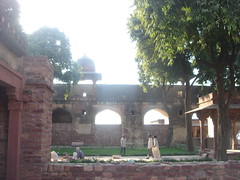
Now, if you're a king you've got to live somewhere. These gardens are near the royal residence. The Mughal (Muslim) king had three wives, a Hindu, Christian, and Muslim. They each had their own quarters.
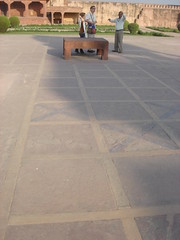
Also, if you're a king, you need to play games. Games like Parcheesi, but played life size, with women wearing different colored outfits as the playing pieces. It's good to be the king.
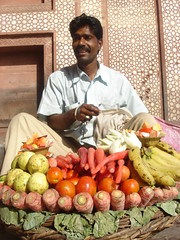
You need enough fruits and vegetables to be healthy. You also need enough servings of photographs of fruits, vegetables, and Indian women dressed in their star burst clothing to keep your blog and flickr stream colorful.
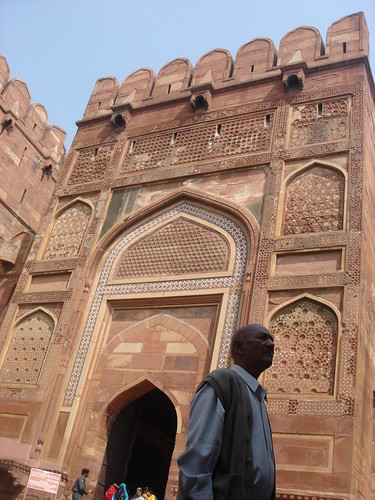
Back in Agra, more Mughal morsels: Agra Fort. It's big and awesome. The Brits used it for many years and leveled many of the structures inside the compound to build barracks. They also took many of the jewels from the Taj, but it's beauty is undiminished, we understand, in absolute terms.

Agra fort has a moat that used to be filled with crocodiles. Or tigers. Or something. Something that would eat you, and swim around. The fort, rather than satisfy our boyish yearnings for castles, only stoke them. We must go to Rajasthan, if we are to attempt any kind of satisfaction.
We aspire to great things. Card carrying Taj-Mahalians. Becoming a member of this elite class requires paying lots of money, none of which is used to put up signs explaining their strict, and time consuming, security procedures. Is the Taj Mahal worth it? Yes. I've seen pictures, but it is truly a sight to behold in person.
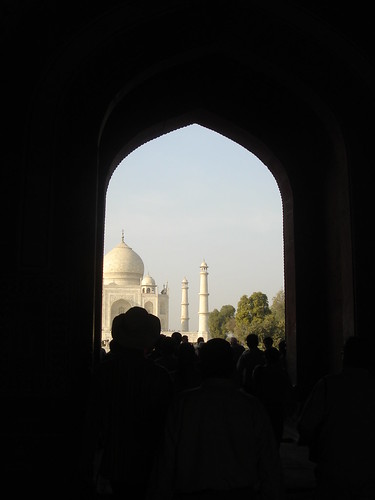
You step through a portal, and then -- Bam! One of the most beautiful man made things you'll ever see in your life, a thousand tons of marble, lands precisely on your head, crushing you.
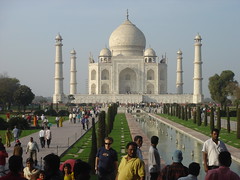
Other people, poets, have described it better than this. Rabindranath Tagore described it as a "one tear-drop...upon the cheek of time." There's an interesting story in the Taj-Mahal, which has many teardrop shapes in it, that makes the sadness here more interesting. The King, Shah Jahan, was so heartbroken when his Queen died, that he built her this beautiful tomb, at great expense. It took 17 years to make, and according to my math, the current price of gold in USD, and some text at the monument -- 213 million dollars. You can check my quick math here, if you like. Afterwards, his son overthrew him, and he had to live out the rest of his life imprisoned at Agra Fort, where he could only look across the city at this monument. He is also buried in the Taj.

The inside of the Taj is not pictured so often, and it's also very lovely. Above, a peek out a carved screen into one of the adjacent structures that mirrors the Taj.
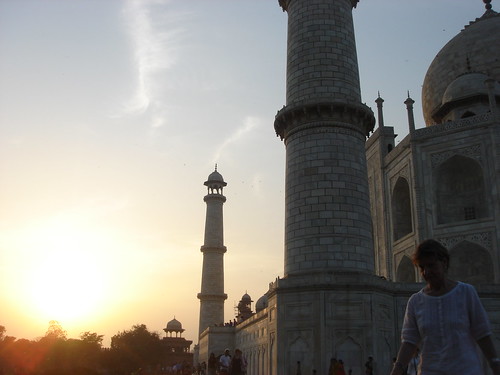
All this awesome Mughal architecture makes me appreciate something. The kings of Europe, living in their big rock heaps called castles, would seem to be paupers in comparison to the Mughal rulers of India. The level of decoration and luxury they had -- sophisticated carvings, air conditioning, and so on -- puts them light years ahead of European rulers. It also explains why the Europeans wanted to trade with India, and China, of course, so much. They had all the booty. The Paneer Tikka Masala, the jewels, carvings, silks from China, the artisans. India's wealth, to a European King, was the jackpot, the big bam bazoodie.
But actually, this isn't true. This architecture is happening around the time of the Renaissance, so the Europeans are building equally gilded and romantic things. But they still desire the Tikka Masala. Who doesn't, deep down inside?

Alex and I have accomplished quite a lot. Having now been to Varanasi, the Taj-Mahal, and Idaho, we can die happy -- having knocked off at least three things on the must-see before you die list. It's time to retire from this itinerant lifestyle. But not so fast. We still have a cell phone in Hindi, and know how to book train and bus tickets, so perhaps we'll go where it's a bit hotter, then a bit colder.
4 comments:
Well, I have to admit that I got a little worked up when I read, "edition packed with adventure, romance, and architecture." Romance!! You see, my son never confides in me and I thought, maybe......
I thought I saw pix with Chabbad. Am I right??
Alas, it was the King Shah Jahan's romance.
jah.
um. there is a flight from delhi on april 1st, arriving sfo april 1st. i'm pretty sure i'll be on it.
"I even finish bargaining with a rickshaw driver at one point, and do such a good job, he asks me if I'm Israeli. I am, I guess, but not how he means it -- as one of the hard bargaining Israeli travelers of legend. That's right, we're acquiring Skillz."
NICE.
Post a Comment